Somatosensation

- Notes
Preparing for the MCAT necessitates a profound comprehension of somatosensation, essential for mastering Organ Systems. Understanding touch, temperature, pain, and proprioception equips you with crucial insights into sensory processing, vital for excelling on the MCAT and understanding complex neural functions.
Learning Objective
In studying Somatosensation for the MCAT, you should develop an understanding of the sensory systems responsible for detecting touch, temperature, pain, and proprioception. Explore the roles of mechanoreceptors, thermoreceptors, nociceptors, and proprioceptors in sensory signal transduction. Evaluate how sensory pathways, like the dorsal column-medial lemniscus and spinothalamic tracts, transmit somatosensory information to the brain. Additionally, understand how this sensory processing is critical to body awareness, environmental interaction, and pain perception. Apply this knowledge to interpreting clinical cases, such as neuropathy and phantom limb syndrome, and solving MCAT practice questions on sensory functions and disorders.
1. Introduction To Somatosensation
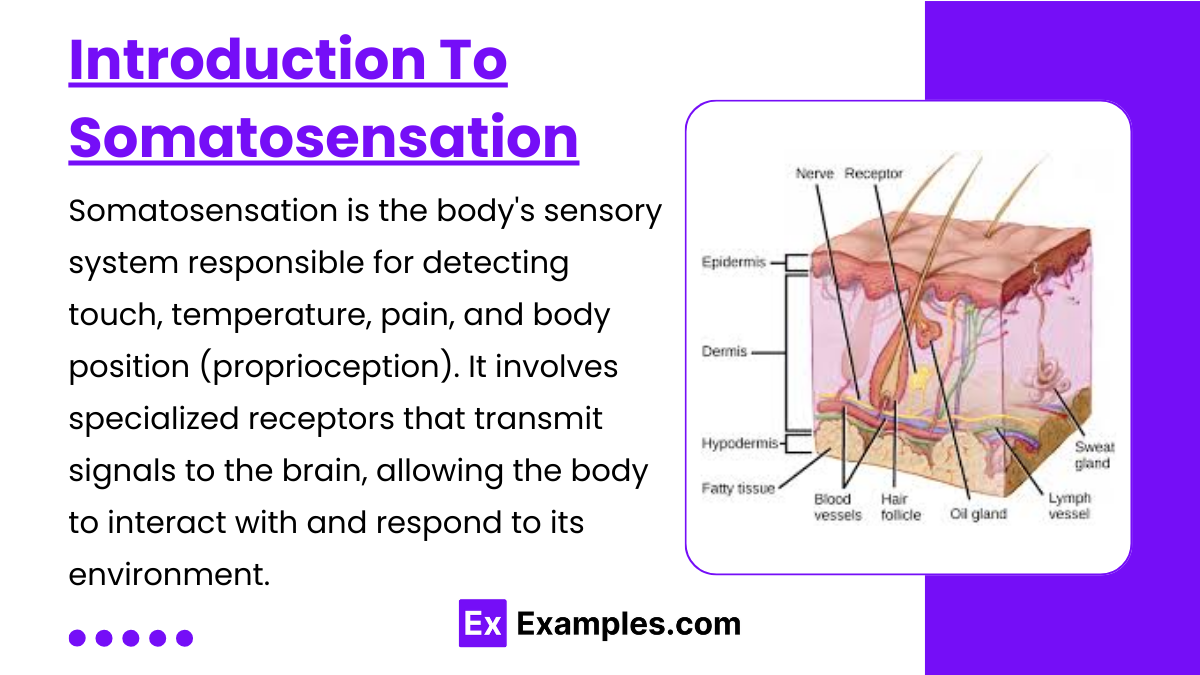
Somatosensation is the sensory system that allows the human body to detect a variety of stimuli that arise from the environment and the body itself. These stimuli include:
- Touch (Tactile sensation)
- Temperature (Thermoreception)
- Pain (Nociception)
- Body Position/Movement (Proprioception)
These sensations are processed by specialized sensory receptors that send signals to the central nervous system (CNS) for interpretation.
2. Types of Somatosensory Receptors
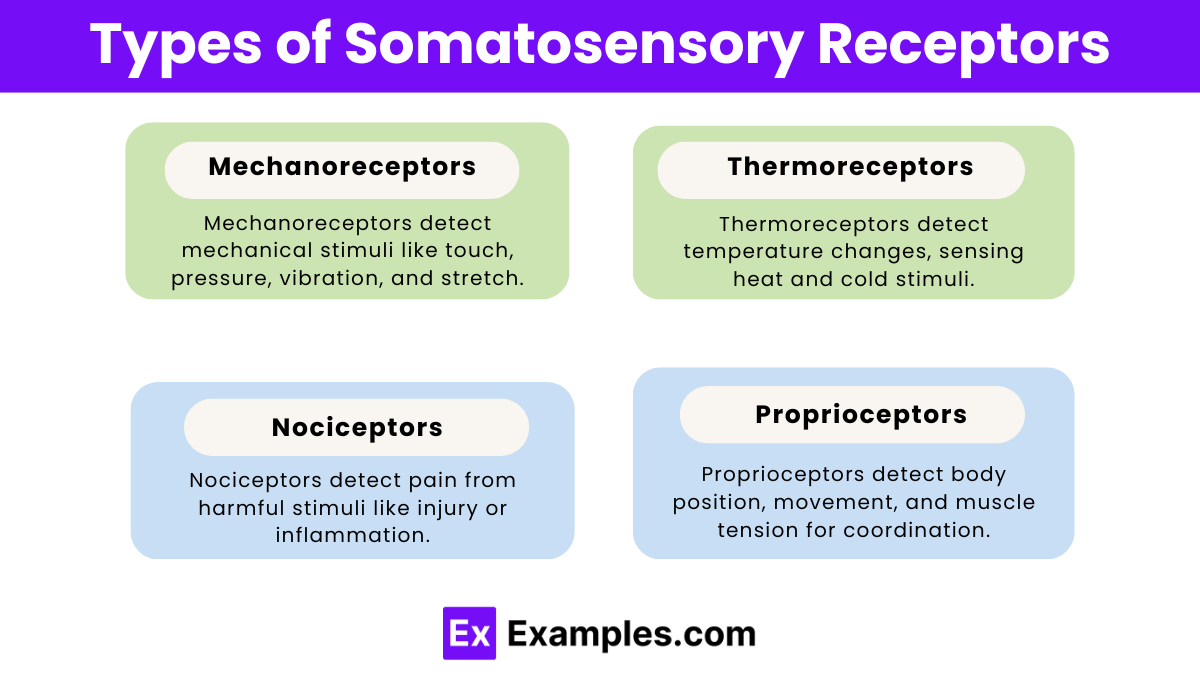
The sensory system relies on various specialized receptors to detect specific types of stimuli. Each receptor type plays a distinct role in sensory perception:
A. Mechanoreceptors (Touch and Pressure)
- Location: Skin (especially in fingertips and other sensitive areas)
- Function: Detect mechanical changes like pressure, vibration, and texture.
- Examples:
- Pacinian Corpuscles: Detect deep pressure and vibration.
- Meissner’s Corpuscles: Detect light touch and texture.
- Merkel Discs: Detect sustained pressure and fine touch.
- Ruffini Endings: Detect stretch and skin deformation.
B. Thermoreceptors (Temperature)
- Location: Skin, mucous membranes
- Function: Detect temperature changes (heat and cold).
- Types:
- Cold Receptors: Activate at cooler temperatures.
- Warm Receptors: Activate at warmer temperatures.
- Extreme temperatures activate nociceptors (pain receptors) instead.
C. Nociceptors (Pain)
- Location: Throughout the body (skin, muscles, joints, organs)
- Function: Detect harmful stimuli that may cause damage, such as extreme pressure, temperature, or tissue injury.
- Types:
- Mechanical nociceptors: Respond to cutting, crushing, or pinching.
- Thermal nociceptors: Respond to extreme heat or cold.
- Polymodal nociceptors: Respond to multiple types of stimuli.
D. Proprioceptors (Body Position)
- Location: Muscles, tendons, joints
- Function: Detect the position and movement of the body.
- Examples:
- Muscle Spindles: Detect muscle stretch and length.
- Golgi Tendon Organs: Detect changes in muscle tension.
- Joint Receptors: Provide information about joint position.
3. Somatosensory Pathways
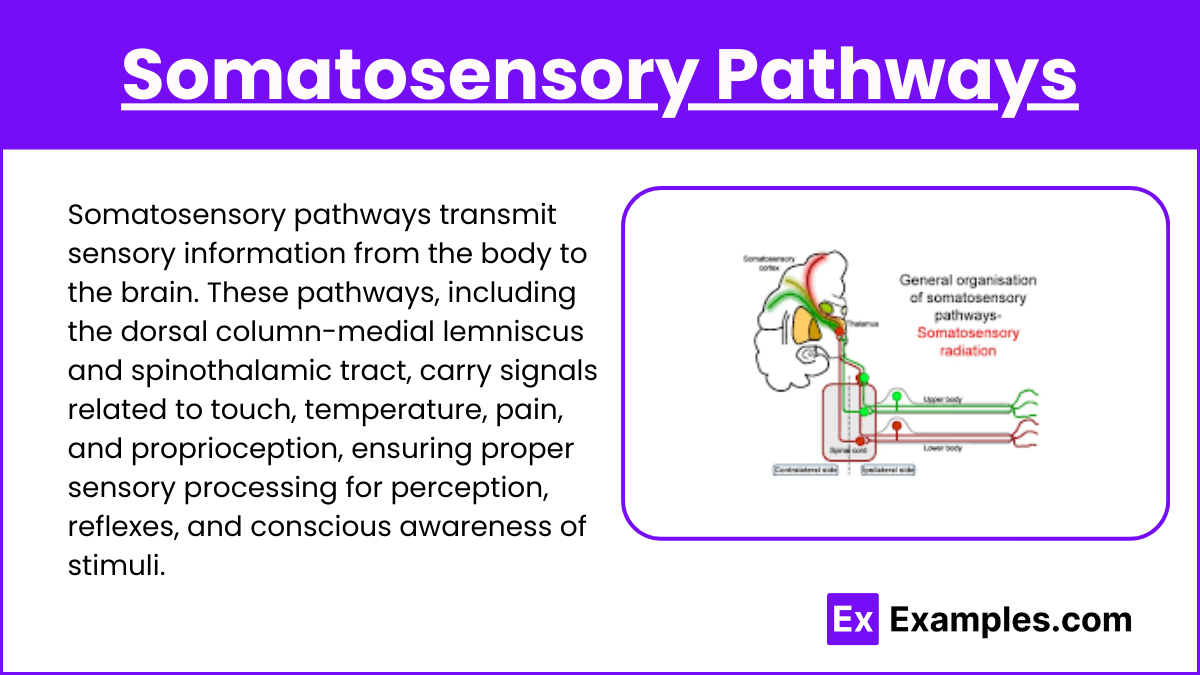
The somatosensory system uses specific neural pathways to transmit sensory information from the body to the brain. These pathways ensure that sensory input is processed accurately and efficiently.
A. Dorsal Column-Medial Lemniscus Pathway (DCML)
- Function: Carries information about fine touch, vibration, and proprioception.
- Pathway:
- Sensory information enters the spinal cord.
- Ascends through the dorsal columns to the medulla.
- Crosses over to the opposite side (decussation) and ascends to the thalamus.
- Relays to the somatosensory cortex in the parietal lobe.
B. Spinothalamic Pathway
- Function: Carries information about pain, temperature, and crude touch.
- Pathway:
- Sensory information enters the spinal cord.
- Crosses over to the opposite side in the spinal cord.
- Ascends through the spinothalamic tract to the thalamus.
- Relays to the somatosensory cortex for processing.
C. Trigeminal Pathway (for the face)
- Function: Carries somatosensory information from the face.
- Pathway:
- Sensory information from the face enters the brainstem via the trigeminal nerve (Cranial Nerve V).
- Similar pathways as DCML and spinothalamic tracts to process the information.
4. Somatosensory Cortex
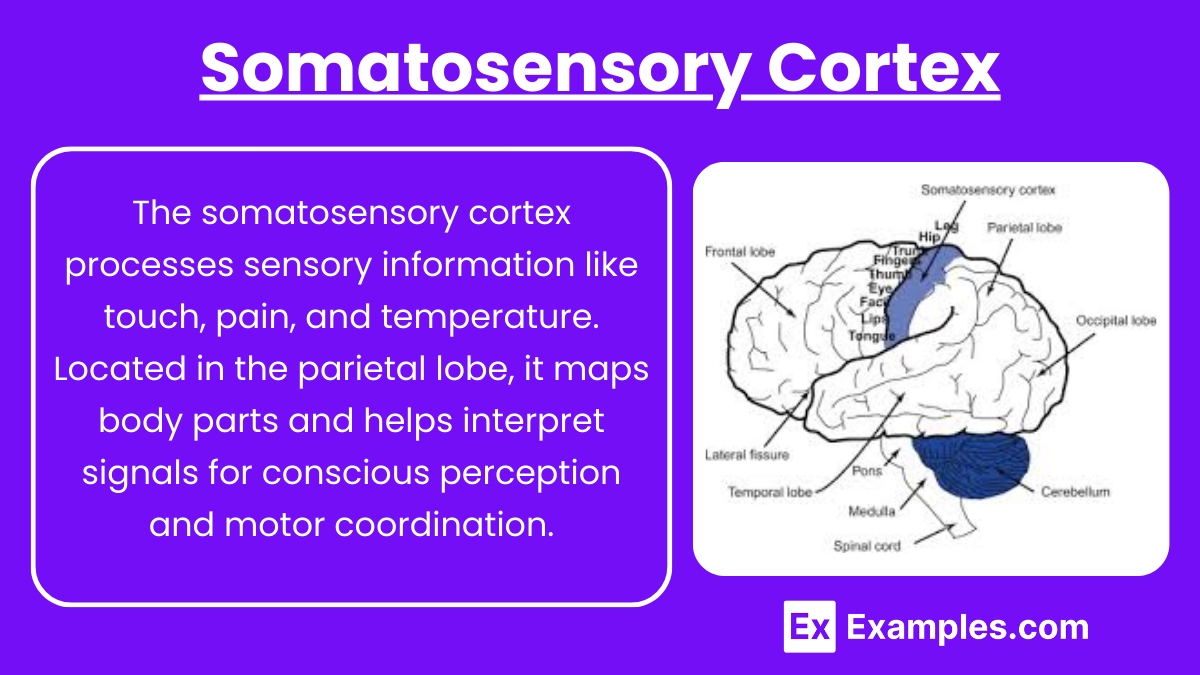
The somatosensory cortex, located in the parietal lobe of the brain, processes sensory information from the body. The primary somatosensory cortex (S1) is organized in a way that corresponds to different parts of the body, forming a sensory map called the homunculus.
A. Location of the Somatosensory Cortex
The somatosensory cortex is located in the parietal lobe, specifically in the postcentral gyrus, just behind the central sulcus of the brain.
B. Function of the Somatosensory Cortex
It processes sensory information related to touch, pressure, pain, temperature, and proprioception, allowing the brain to interpret and respond to these stimuli.
C. Somatosensory Homunculus
The cortex is organized into a map called the somatosensory homunculus, representing different body parts proportionally to their sensory receptor density.
D. Primary and Secondary Somatosensory Areas
The primary somatosensory cortex (S1) handles initial processing, while the secondary somatosensory cortex (S2) integrates and further interprets sensory input.
5. Clinical Relevance: Conditions Affecting Somatosensation
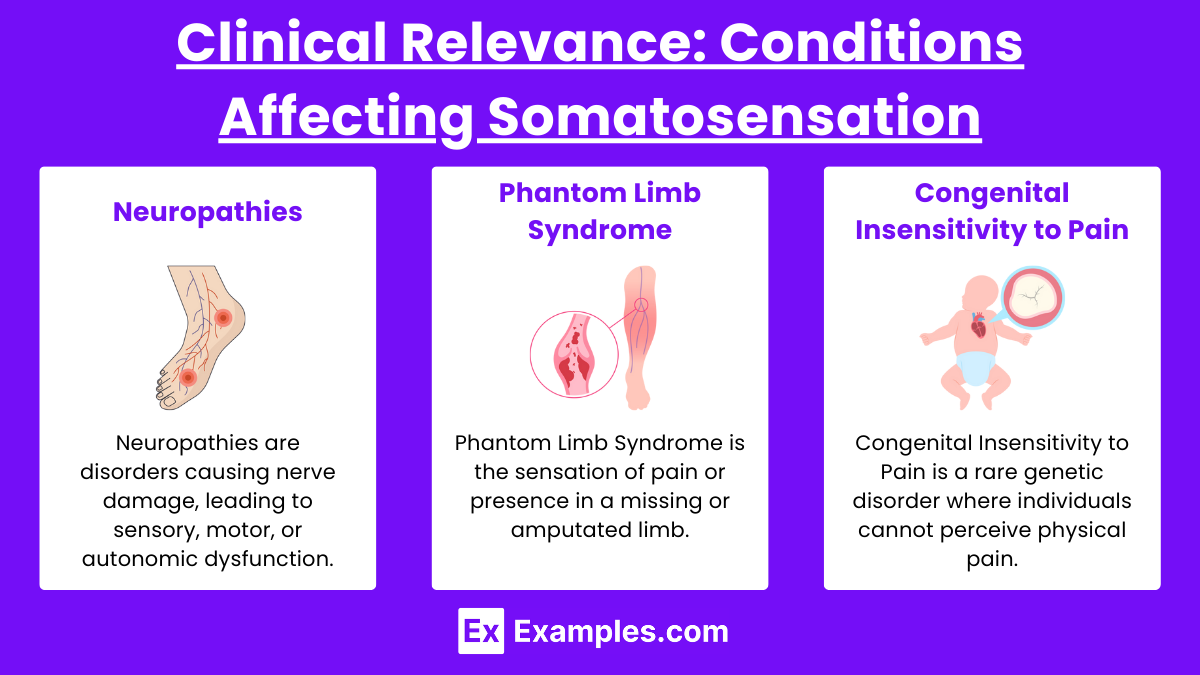
Understanding somatosensation helps explain several medical conditions that could be tested on the MCAT:
A. Neuropathies
- Diabetic Neuropathy: Damage to sensory neurons leading to loss of sensation, especially in the feet.
- Carpal Tunnel Syndrome: Compression of the median nerve, affecting sensory input from the hand.
B. Phantom Limb Syndrome
- Cause: After amputation, patients may still perceive sensations, including pain, from the missing limb. This occurs due to the brain’s map (homunculus) still representing the limb.
C. Congenital Insensitivity to Pain
- Cause: A rare genetic disorder where individuals cannot feel pain, leading to unintentional injuries.
Examples
Example 1: Sensory Receptor Activation
- A mechanoreceptor in the skin is activated by a light touch.
- The receptor converts the mechanical stimulus into an electrical signal (action potential).
- This signal is transmitted through afferent sensory neurons to the spinal cord and brain, where it is processed, allowing for the perception of touch.
Example 2: Role of Proprioceptors in Body Movement
- Proprioceptors located in muscles and joints detect changes in body position and movement.
- Muscle spindles sense muscle stretch, while Golgi tendon organs detect tension.
- These receptors help maintain balance and coordination by sending feedback to the central nervous system.
Example 3: Effects of Temperature on Thermoreceptors
- Thermoreceptors respond to changes in skin temperature.
- Cold thermoreceptors activate when skin temperature drops, while warm thermoreceptors respond to heat.
- Extreme temperatures activate nociceptors, leading to the sensation of pain, protecting the body from potential damage.
Example 4: Pain Perception through Nociceptors
- Nociceptors in the skin detect harmful stimuli, such as a sharp object or heat.
- The receptors generate action potentials that travel to the brain, resulting in the perception of pain, which triggers protective reflexes or behavioral responses.
Example 5: Phantom Limb Sensation after Amputation
- In Phantom Limb Syndrome, patients may continue to experience sensations, including pain, in a missing limb.
- This occurs due to the brain’s persistent neural representation of the limb, even though the sensory input has ceased.
Practice Questions
Question 1:
Which of the following receptor types is responsible for detecting changes in body position?
- A) Mechanoreceptors
- B) Nociceptors
- C) Proprioceptors
- D) Thermoreceptors
Answer: C) Proprioceptors
Explanation: Proprioceptors, found in muscles and joints, provide the brain with information about the position and movement of the body.
Question 2:
Which type of receptor detects painful stimuli like heat or injury?
- A) Mechanoreceptors
- B) Nociceptors
- C) Thermoreceptors
- D) Proprioceptors
Answer: B) Nociceptors
Explanation: Nociceptors detect harmful stimuli, triggering the sensation of pain to protect the body from damage.
Question 3:
What is the primary function of thermoreceptors in the somatosensory system?
- A) Detect body position
- B) Sense temperature changes
- C) Perceive pain
- D) Respond to pressure
Answer: B) Sense temperature changes
Explanation: Thermoreceptors are specialized receptors that detect temperature variations, activating when skin temperature rises or falls.
Preparing for the MCAT necessitates a profound comprehension of somatosensation, essential for mastering Organ Systems. Understanding touch, temperature, pain, and proprioception equips you with crucial insights into sensory processing, vital for excelling on the MCAT and understanding complex neural functions.
Learning Objective
In studying Somatosensation for the MCAT, you should develop an understanding of the sensory systems responsible for detecting touch, temperature, pain, and proprioception. Explore the roles of mechanoreceptors, thermoreceptors, nociceptors, and proprioceptors in sensory signal transduction. Evaluate how sensory pathways, like the dorsal column-medial lemniscus and spinothalamic tracts, transmit somatosensory information to the brain. Additionally, understand how this sensory processing is critical to body awareness, environmental interaction, and pain perception. Apply this knowledge to interpreting clinical cases, such as neuropathy and phantom limb syndrome, and solving MCAT practice questions on sensory functions and disorders.
1. Introduction To Somatosensation

Somatosensation is the sensory system that allows the human body to detect a variety of stimuli that arise from the environment and the body itself. These stimuli include:
Touch (Tactile sensation)
Temperature (Thermoreception)
Pain (Nociception)
Body Position/Movement (Proprioception)
These sensations are processed by specialized sensory receptors that send signals to the central nervous system (CNS) for interpretation.
2. Types of Somatosensory Receptors

The sensory system relies on various specialized receptors to detect specific types of stimuli. Each receptor type plays a distinct role in sensory perception:
A. Mechanoreceptors (Touch and Pressure)
Location: Skin (especially in fingertips and other sensitive areas)
Function: Detect mechanical changes like pressure, vibration, and texture.
Examples:
Pacinian Corpuscles: Detect deep pressure and vibration.
Meissner's Corpuscles: Detect light touch and texture.
Merkel Discs: Detect sustained pressure and fine touch.
Ruffini Endings: Detect stretch and skin deformation.
B. Thermoreceptors (Temperature)
Location: Skin, mucous membranes
Function: Detect temperature changes (heat and cold).
Types:
Cold Receptors: Activate at cooler temperatures.
Warm Receptors: Activate at warmer temperatures.
Extreme temperatures activate nociceptors (pain receptors) instead.
C. Nociceptors (Pain)
Location: Throughout the body (skin, muscles, joints, organs)
Function: Detect harmful stimuli that may cause damage, such as extreme pressure, temperature, or tissue injury.
Types:
Mechanical nociceptors: Respond to cutting, crushing, or pinching.
Thermal nociceptors: Respond to extreme heat or cold.
Polymodal nociceptors: Respond to multiple types of stimuli.
D. Proprioceptors (Body Position)
Location: Muscles, tendons, joints
Function: Detect the position and movement of the body.
Examples:
Muscle Spindles: Detect muscle stretch and length.
Golgi Tendon Organs: Detect changes in muscle tension.
Joint Receptors: Provide information about joint position.
3. Somatosensory Pathways

The somatosensory system uses specific neural pathways to transmit sensory information from the body to the brain. These pathways ensure that sensory input is processed accurately and efficiently.
A. Dorsal Column-Medial Lemniscus Pathway (DCML)
Function: Carries information about fine touch, vibration, and proprioception.
Pathway:
Sensory information enters the spinal cord.
Ascends through the dorsal columns to the medulla.
Crosses over to the opposite side (decussation) and ascends to the thalamus.
Relays to the somatosensory cortex in the parietal lobe.
B. Spinothalamic Pathway
Function: Carries information about pain, temperature, and crude touch.
Pathway:
Sensory information enters the spinal cord.
Crosses over to the opposite side in the spinal cord.
Ascends through the spinothalamic tract to the thalamus.
Relays to the somatosensory cortex for processing.
C. Trigeminal Pathway (for the face)
Function: Carries somatosensory information from the face.
Pathway:
Sensory information from the face enters the brainstem via the trigeminal nerve (Cranial Nerve V).
Similar pathways as DCML and spinothalamic tracts to process the information.
4. Somatosensory Cortex

The somatosensory cortex, located in the parietal lobe of the brain, processes sensory information from the body. The primary somatosensory cortex (S1) is organized in a way that corresponds to different parts of the body, forming a sensory map called the homunculus.
A. Location of the Somatosensory Cortex
The somatosensory cortex is located in the parietal lobe, specifically in the postcentral gyrus, just behind the central sulcus of the brain.
B. Function of the Somatosensory Cortex
It processes sensory information related to touch, pressure, pain, temperature, and proprioception, allowing the brain to interpret and respond to these stimuli.
C. Somatosensory Homunculus
The cortex is organized into a map called the somatosensory homunculus, representing different body parts proportionally to their sensory receptor density.
D. Primary and Secondary Somatosensory Areas
The primary somatosensory cortex (S1) handles initial processing, while the secondary somatosensory cortex (S2) integrates and further interprets sensory input.
5. Clinical Relevance: Conditions Affecting Somatosensation

Understanding somatosensation helps explain several medical conditions that could be tested on the MCAT:
A. Neuropathies
Diabetic Neuropathy: Damage to sensory neurons leading to loss of sensation, especially in the feet.
Carpal Tunnel Syndrome: Compression of the median nerve, affecting sensory input from the hand.
B. Phantom Limb Syndrome
Cause: After amputation, patients may still perceive sensations, including pain, from the missing limb. This occurs due to the brain’s map (homunculus) still representing the limb.
C. Congenital Insensitivity to Pain
Cause: A rare genetic disorder where individuals cannot feel pain, leading to unintentional injuries.
Examples
Example 1: Sensory Receptor Activation
A mechanoreceptor in the skin is activated by a light touch.
The receptor converts the mechanical stimulus into an electrical signal (action potential).
This signal is transmitted through afferent sensory neurons to the spinal cord and brain, where it is processed, allowing for the perception of touch.
Example 2: Role of Proprioceptors in Body Movement
Proprioceptors located in muscles and joints detect changes in body position and movement.
Muscle spindles sense muscle stretch, while Golgi tendon organs detect tension.
These receptors help maintain balance and coordination by sending feedback to the central nervous system.
Example 3: Effects of Temperature on Thermoreceptors
Thermoreceptors respond to changes in skin temperature.
Cold thermoreceptors activate when skin temperature drops, while warm thermoreceptors respond to heat.
Extreme temperatures activate nociceptors, leading to the sensation of pain, protecting the body from potential damage.
Example 4: Pain Perception through Nociceptors
Nociceptors in the skin detect harmful stimuli, such as a sharp object or heat.
The receptors generate action potentials that travel to the brain, resulting in the perception of pain, which triggers protective reflexes or behavioral responses.
Example 5: Phantom Limb Sensation after Amputation
In Phantom Limb Syndrome, patients may continue to experience sensations, including pain, in a missing limb.
This occurs due to the brain’s persistent neural representation of the limb, even though the sensory input has ceased.
Practice Questions
Question 1:
Which of the following receptor types is responsible for detecting changes in body position?
A) Mechanoreceptors
B) Nociceptors
C) Proprioceptors
D) Thermoreceptors
Answer: C) Proprioceptors
Explanation: Proprioceptors, found in muscles and joints, provide the brain with information about the position and movement of the body.
Question 2:
Which type of receptor detects painful stimuli like heat or injury?
A) Mechanoreceptors
B) Nociceptors
C) Thermoreceptors
D) Proprioceptors
Answer: B) Nociceptors
Explanation: Nociceptors detect harmful stimuli, triggering the sensation of pain to protect the body from damage.
Question 3:
What is the primary function of thermoreceptors in the somatosensory system?
A) Detect body position
B) Sense temperature changes
C) Perceive pain
D) Respond to pressure
Answer: B) Sense temperature changes
Explanation: Thermoreceptors are specialized receptors that detect temperature variations, activating when skin temperature rises or falls.

